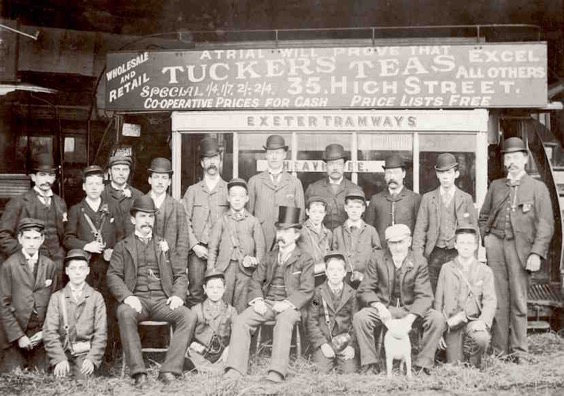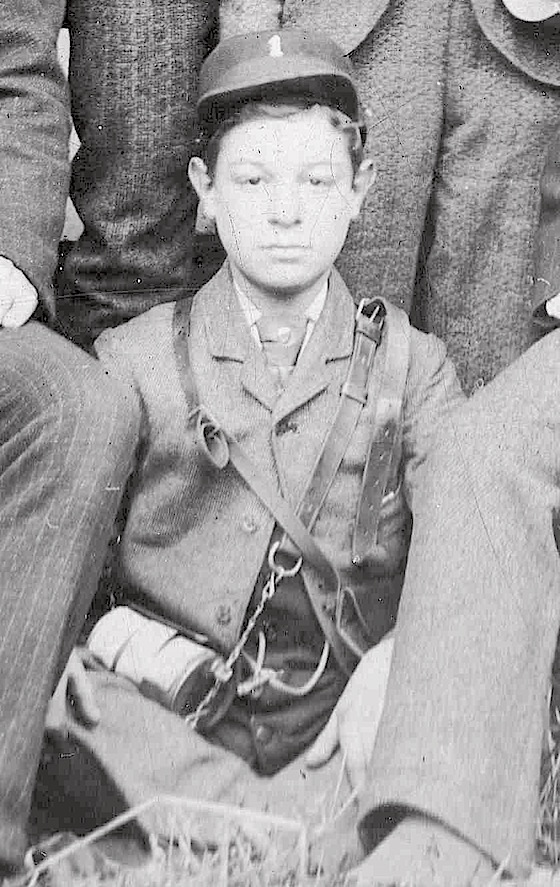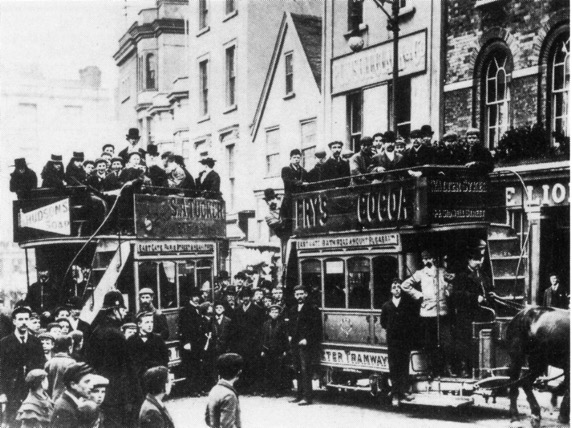Exeter Tramways
History
Powers to build a horse tramway in Exeter were obtained on the 18th July 1881 under the Exeter Tramways Act, 1881; the same act also incorporated a company — the Exeter Tramways Company — that would build and operate the tramway. The company was launched at the Black Horse Inn in Exeter on the 15th November 1881.
Work commenced on the 3rd January 1882, with the first section — between London Inn Square and St Lukes College— opening on the 6th April 1882 using three horsecars. The remainder of the lines did not follow until the 1st August 1883, by which time another three horsecars had been acquired, two more following in 1884.
This took the 3ft 6ins-gauge tramway to its final size of 2.34 miles. From London Inn Square, lines ran: northwestwards via New North Road, Hele Road and St Davids Hill to the Great Western Railway Company's station at St Davids; northeastwards to Mount Pleasant Road via Sidwell Street and Bath Road (now Blackboy Road); and southeastwards to Livery Dole via Paris Street and Heavitree Road. Another short branch along Queen Street was authorised but not built, whilst another, along High Street to the city centre was proposed, but was dropped due to objections. The failure to access the main thoroughfares in the city centre left the company with a barely viable system, which was destined to struggle financially throughout its life.
By 1888, the company's financial challenges were so great that it was subject to a compulsory winding-up order, on the 1st March, and a liquidator was appointed. The liquidator was presumably tasked with putting the system on a sound financial footing, and then finding a buyer, but in the latter task he failed, which resulted in the company being dissolved on the 7th August 1889. It is not clear what happened next, though horse bus services to outlying areas were apparently introduced that same year. The tramway evidently continued in operation until 1892, when it passed into the hands of a group of London-based financiers, who formed a company — the Tramway Purchase Syndicate (in July 1892) — to run their new acquisition. The company did, however, not operate the tramway itself, but instead leased it to a local concern, Frederick Burt and Company.
Two tramcars were purchased in 1896 to replace two of the original cars, with the last car of all, a secondhand car from Plymouth Corporation following in 1900.
The owners managed to continue operation, on a shoe string, for the best part of a decade, but by the turn of the century the tramway's days were clearly numbered, not only by the advent of the electric tramcar, but by the threat of municipalisation. Under the Tramways Act of 1870, Exeter Corporation had the right to compulsory purchase the tramway 21 years after the passing of the enablement act, a date that would fall due in 1902.
It would seem that the TPS sold the tramway to the lessees (Frederick Burt and Company) in early 1899, the latter subsequently offering to sell the entire undertaking to the corporation in April 1899; the offer was, however, rejected, probably because the corporation were not ready to take it over. The tramway therefore limped on awaiting the inevitable, the FB&Co cutting costs by abandoning the route to the station (in 1902); this traversed a very steep hill (St Davids Hill), which required the use of additional horses (so-called trace horses), which made it especially expensive to operate.
With the 1902 date looming, the corporation commissioned a report into the tramway, which recommended conversion to electric traction using overhead current collection. In December 1902, the council conducted a public poll to gauge support for an electric tramway, over over three-quarters voting for it. The corporation then sought powers to take over the tramway, convert it to electric traction, and build extensions to it; these powers were granted on the 1st August 1903 under the Exeter Corporation Tramways Act 1903.
Following arbitration, the tramway, along with five horsecars and 22 horses, passed into corporation ownership on the 1st February 1904. The latter operated the horse tramway for 14 months, the last horse trams being withdrawn on the day electric services began, the 4th April 1905.
Uniforms
Photographss of Exeter's horse tramways taken prior to 1904 (the year of the corporation take-over) are surprisingly rare given the fact that they had been plying their trade for a good 22 years prior to this. Fortunately, the excellent staff photograph shown below, almost certainly taken in the early 1880s, clearly shows the general attire of both conductors and drivers. As was frequently the case with horse tramway operators, drivers tended to wear smart but informal attire comprising trousers, jacket, waistcoat and tie, plus long coachman-style overcoats; no insignia of any kind was worn. Headgear essentially followed the fashion of the day, namely, the bowler hat, with the occasional flat cap probably putting in an appearance in later years.
Conductors, who in the early days at least, appear to have been boys rather than adults, wore similar attire, but with a kepi-style cap; this was presumably issued by the company, and bore an employee number, very probably made of brass or nickel (see below). Given the sparsity of photographs, it is impossible to state with any degree of certainty whether the kepi caps continued in continuous use up until municipalisation.
Photographs of inspectors are unknown, and it is entirely possible that the ETCo never made use of them.
Further reading
For a history of Exeter's horse tramway, see: 'Exeter: a Century of Public Transport' by R C Sambourne; Glasney Press (1976). For a pictorial history of Exeter's tramways, see: 'Exeter and Taunton Tramways' by J Perkin; Middleton Press (1994).
Images
Horse tram drivers and conductors
Staff photo — date unknown, but very probably taken in the early years of the tramway company’s life, i.e., the 1880s. Of those assembled, eight are conductors, with all but one wearing kepi-style caps; all eight are very young, which was probably a deliberate policy of the company, no doubt aimed at keeping the wage bill as low as possible. The gentleman in the centre is probably either the chairman or a significant shareholder. With thanks to David Bryant.
An enlargement of the above photograph showing a very young conductor (No 1). The jacket was probably self-purchased, with the kepi-style cap being issued by the company, in order to confer a level of officialdom on the wearer.
A photograph of two horse trams at the junction of High Street, Paris Street and Sidwell Street — photo undated, but possibly taken in the 1890s. The two drivers are wearing bowler hats and long coachman-style overcoats. Photo courtesy of the Tramways and Light Railway Society, with thanks to David Voice.